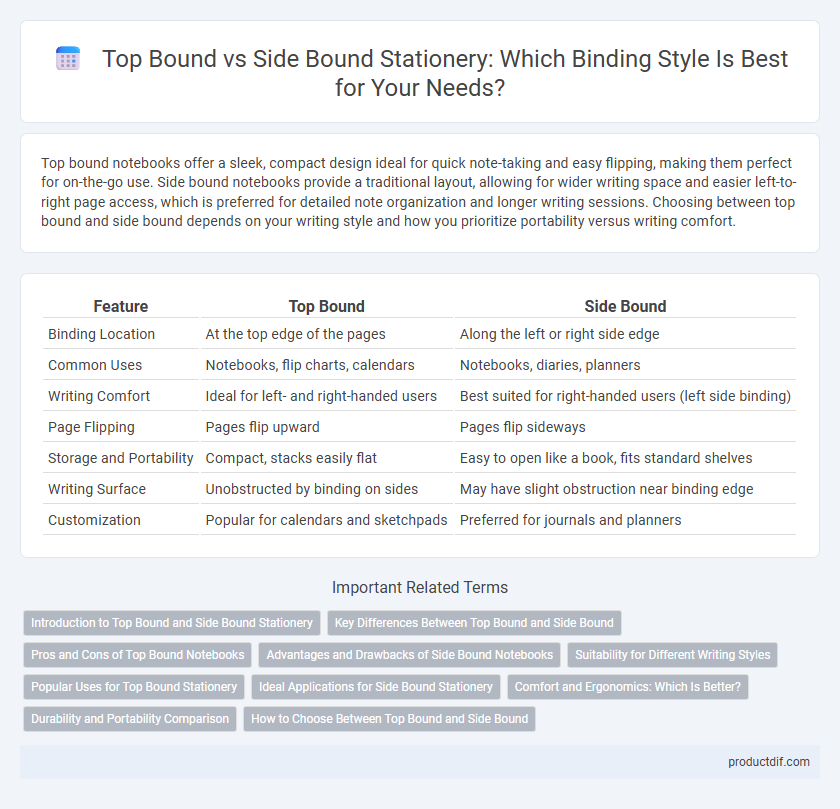Top bound notebooks offer a sleek, compact design ideal for quick note-taking and easy flipping, making them perfect for on-the-go use. Side bound notebooks provide a traditional layout, allowing for wider writing space and easier left-to-right page access, which is preferred for detailed note organization and longer writing sessions. Choosing between top bound and side bound depends on your writing style and how you prioritize portability versus writing comfort.
Table of Comparison
| Feature | Top Bound | Side Bound |
|---|---|---|
| Binding Location | At the top edge of the pages | Along the left or right side edge |
| Common Uses | Notebooks, flip charts, calendars | Notebooks, diaries, planners |
| Writing Comfort | Ideal for left- and right-handed users | Best suited for right-handed users (left side binding) |
| Page Flipping | Pages flip upward | Pages flip sideways |
| Storage and Portability | Compact, stacks easily flat | Easy to open like a book, fits standard shelves |
| Writing Surface | Unobstructed by binding on sides | May have slight obstruction near binding edge |
| Customization | Popular for calendars and sketchpads | Preferred for journals and planners |
Introduction to Top Bound and Side Bound Stationery
Top bound stationery features sheets bound along the longer edge, commonly seen in legal pads and notepads, allowing for easy flipping and writing on both sides. Side bound stationery typically has binding on the shorter edge, as with spiral notebooks, facilitating page turning like a traditional book. Choosing between top bound and side bound depends on usage requirements such as writing comfort, ease of page removal, and organizational preferences.
Key Differences Between Top Bound and Side Bound
Top bound notebooks feature a binding strip along the upper edge, allowing pages to be flipped upwards, making them ideal for quick note-taking and easy access. Side bound notebooks have the binding on the left edge, facilitating traditional page turning and offering a stable writing surface favored in formal settings. Key differences include usability preferences, flipping direction, and suitability for specific tasks or environments.
Pros and Cons of Top Bound Notebooks
Top bound notebooks offer a seamless writing experience ideal for left-handed users, minimizing smudging and enhancing legibility by keeping the binding at the top. Their compact design supports efficient flip-over pages, making them perfect for quick note-taking and form filling in tight spaces. However, the limited binding space may restrict the number of pages, potentially reducing durability for extensive note collections.
Advantages and Drawbacks of Side Bound Notebooks
Side bound notebooks offer enhanced durability and ease of use, allowing users to comfortably write on both sides of the page without interference from the binding. Their design facilitates quick page flipping and better organization, making them ideal for note-taking and journaling. However, the side binding can sometimes lead to reduced page capacity compared to top bound notebooks, and the notebook may take up more desk space when laid flat.
Suitability for Different Writing Styles
Top bound notebooks are ideal for left-handed writers and artists who prefer vertical space for sketching or note-taking, offering ease of flipping pages without hand obstruction. Side bound notebooks suit right-handed writers and students who favor traditional book layouts and horizontal writing flow, enhancing comfort during extended writing sessions. Selecting the appropriate binding style influences handwriting ergonomics and overall productivity for specific writing styles.
Popular Uses for Top Bound Stationery
Top bound stationery is commonly used for notepads, legal pads, and memo pads, providing easy page flipping from top to bottom. This configuration allows uninterrupted writing space and quick access to entire sheets, making it ideal for note-taking and to-do lists. Its design is favored in classrooms, offices, and meetings where rapid, linear note taking is essential.
Ideal Applications for Side Bound Stationery
Side bound stationery is ideal for notebooks and planners that require easy page flipping and a compact design, commonly used in academic and office settings. This binding style enhances durability and keeps pages securely fastened, making it suitable for frequent handling and note-taking. Side bound notebooks also accommodate a wide variety of page sizes and formats, perfect for customizable or multi-subject use.
Comfort and Ergonomics: Which Is Better?
Top bound notebooks offer a streamlined writing experience by allowing users to flip pages upward, reducing wrist strain and maintaining a natural hand position, which enhances comfort during extended use. Side bound notebooks, commonly spiral or stitched on the left, provide easier access for right-handed users but may cause slight discomfort due to the binding pressing against the hand. Ergonomically, top bound designs generally promote better wrist alignment and reduced muscle fatigue, making them more suitable for prolonged note-taking sessions.
Durability and Portability Comparison
Top bound notebooks offer enhanced portability due to their compact design, allowing for easy flipping and writing on the go, while side bound notebooks provide greater durability with reinforced binding that better withstands frequent use and pressure. Side bound options, particularly spiral-bound or hardcover, maintain structural integrity over time, making them ideal for heavy note-taking and long-term storage. Top bound notebooks, often found in pads or memo books, prioritize convenience and quick access, but may experience faster wear along the binding edge compared to side bound counterparts.
How to Choose Between Top Bound and Side Bound
Choosing between top bound and side bound stationery depends on usage convenience and content layout. Top bound notebooks are ideal for quick note-taking and flip-over access, making them perfect for lists or presentations, while side bound notebooks offer a traditional writing experience suitable for extensive note-taking and detailed work. Consider the writing hand dominance and the space where the notebook will be used to select the most ergonomic binding style.
Top Bound vs Side Bound Infographic

 productdif.com
productdif.com